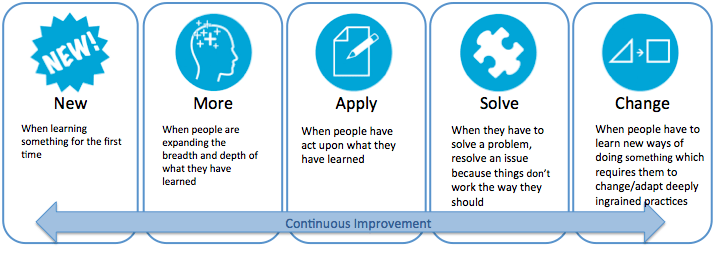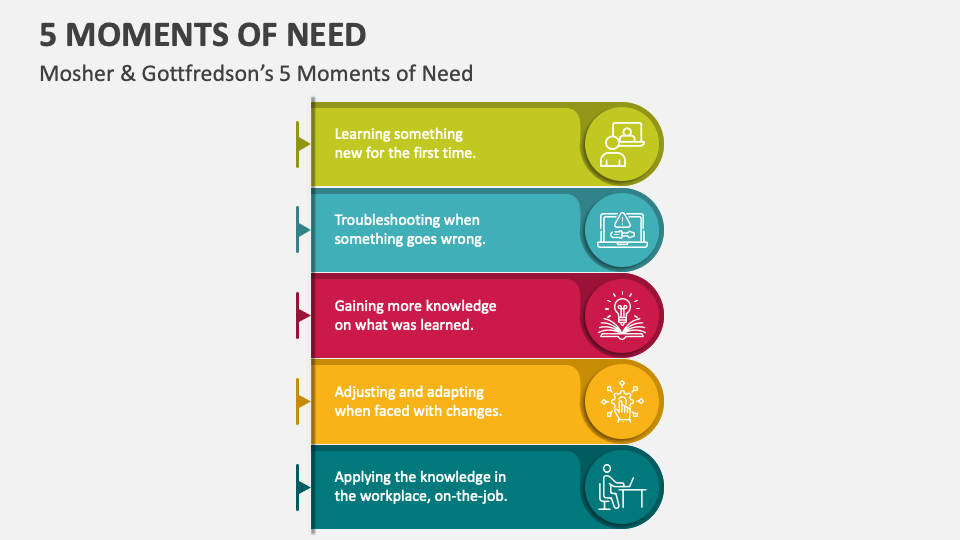In the fast-paced and dynamic world of today’s workforce, the need for continuous learning and development is more critical than ever. To address the diverse learning requirements of employees, Bob Mosher and Conrad Gottfredson introduced the “5 Moments of Need” framework. This groundbreaking concept identifies specific instances when individuals require information and support to enhance their performance. The five key moments include Learning for the first time, Learning More, Applying, Solving, and Changing.

- Learning for the First Time:
The initial phase in the learning journey involves acquiring new knowledge or skills. Whether it’s onboarding new employees or introducing a novel concept, this moment of need centers around providing fundamental information. Effective onboarding programs are crucial to ensure that employees grasp essential concepts, organizational values, and job-specific requirements.
In this moment, traditional training methods may include structured courses, workshops, or e-learning modules. However, with the evolving nature of work, incorporating innovative approaches such as microlearning or mobile learning can enhance engagement and retention during this critical phase.
Scenario 1: Onboarding New Employees
Imagine a new employee joining a company. The first few weeks are crucial for them to understand the organizational culture, values, and their role within the company. In this moment of need, a comprehensive onboarding program is essential. Through a mix of interactive sessions, e-learning modules, and mentorship programs, the organization ensures that the newcomer not only comprehends the basics but also feels integrated into the company’s fabric.
Scenario 2: Introducing New Technology
When a company introduces new technology, employees face the challenge of familiarizing themselves with the tools and applications. A blend of hands-on workshops, simulation-based training, and readily available online resources can address this moment of need. Quick-reference guides and video tutorials become valuable assets, facilitating a smoother transition to the new technological landscape.
- Learning More:
Once individuals have a foundational understanding, the next moment of need arises when they seek to deepen their knowledge and skills. Learning more involves ongoing training, skill development, and staying current with industry trends. This moment often occurs through continuous professional development opportunities, workshops, and access to relevant resources.
To address this need, organizations can implement mentorship programs, encourage participation in webinars or conferences, and provide access to online communities where employees can exchange ideas and insights. This ensures that employees remain motivated and continuously expand their expertise.
Scenario 3: Professional Development
In a rapidly changing business environment, employees need to continually enhance their skills. Scenario-based learning, workshops, and ongoing professional development opportunities come into play. By offering access to online courses, mentorship programs, and encouraging participation in industry conferences, organizations empower their workforce to stay ahead of the curve and remain at the forefront of industry trends.
Scenario 4: Staying Current with Compliance Requirements
Industries subject to frequent regulatory changes, such as finance or healthcare, demand a vigilant approach to compliance. Regular training sessions, webinars, and easily accessible knowledge repositories become essential tools for employees to stay abreast of the latest compliance requirements, ensuring that the organization operates within legal frameworks.
- Applying:
Learning doesn’t end with the acquisition of knowledge; it extends to the practical application of skills in the workplace. The moment of applying is crucial for employees to transfer theoretical knowledge into actionable results. This phase requires a seamless integration of learning into the daily workflow.
Organizations can facilitate this moment by creating a supportive work environment that encourages experimentation and application of new skills. Additionally, implementing performance support tools and job aids can assist employees in real-time, reinforcing their learning as they apply it on the job.
Scenario 5: Implementing New Processes
After acquiring new knowledge, employees need to apply it in their day-to-day tasks. Suppose a company introduces a new project management methodology. In this moment, providing job aids, real-time support through mentorship, and creating a collaborative space for sharing experiences can accelerate the application of new skills, fostering a more efficient workflow.
Scenario 6: Sales Training for Product Launch
For sales teams, applying knowledge is paramount. In preparation for a product launch, sales representatives need not only to understand the product but also to articulate its value proposition effectively. Role-playing exercises, sales simulations, and access to a repository of sales collateral can equip the team to apply their learning in customer interactions.
- Solving:
Challenges and problems are inevitable in any work environment. The moment of solving occurs when employees encounter obstacles that require problem-solving skills. This moment is not just about finding solutions but also about learning from the process of overcoming challenges.
Organizations can support employees in this moment by fostering a culture of collaboration, providing access to knowledge repositories, and encouraging the use of social learning platforms. By creating a learning ecosystem that promotes shared experiences, employees can leverage collective wisdom to navigate complex situations.
Scenario 7: Troubleshooting Technical Issues
In an IT department, employees often encounter technical challenges that require creative problem-solving. Here, a robust knowledge base, collaborative forums, and an internal social platform for sharing solutions become invaluable. The organization encourages a culture of shared problem-solving, enabling employees to tap into the collective intelligence of the team.
Scenario 8: Addressing Customer Complaints
For customer service teams, solving problems is part of their daily routine. Providing access to case studies, real-time support tools, and continuous training on effective problem resolution techniques ensures that employees are equipped to handle diverse customer concerns, enhancing customer satisfaction and loyalty.
- Changing:
The final moment of need occurs when organizations undergo significant changes, whether it’s the introduction of new technologies, processes, or shifts in the market. Employees require support to adapt to these changes and acquire the necessary skills to thrive in the evolving landscape.
During periods of change, organizations should invest in change management training, communication strategies, and continuous feedback mechanisms. This ensures that employees not only understand the reasons behind the changes but also feel equipped to embrace and contribute to the transformation.
Scenario 9: Implementing Organizational Restructuring
During periods of organizational restructuring, employees face uncertainty and the need to adapt to new roles and responsibilities. Change management training, clear communication strategies, and ongoing support mechanisms help employees navigate the transition. In this moment of need, the organization demonstrates a commitment to facilitating a smooth change process.
Scenario 10: Adopting New Leadership Strategies
When leadership introduces a shift in management strategies, such as transitioning to a more collaborative leadership style, employees may find themselves adjusting to a new way of working. Training programs, leadership coaching, and forums for open dialogue facilitate this change, ensuring that employees understand the rationale behind the shift and feel empowered to contribute effectively.
Conclusion:
The 5 Moments of Need framework provides a holistic approach to addressing the diverse learning needs of employees throughout their professional journey. By recognizing and catering to these specific moments, organizations can create a dynamic and supportive learning environment, fostering continuous improvement and adaptability within their workforce. As the workplace continues to evolve, embracing the 5 Moments of Need is key to unlocking performance excellence and ensuring long-term success.











